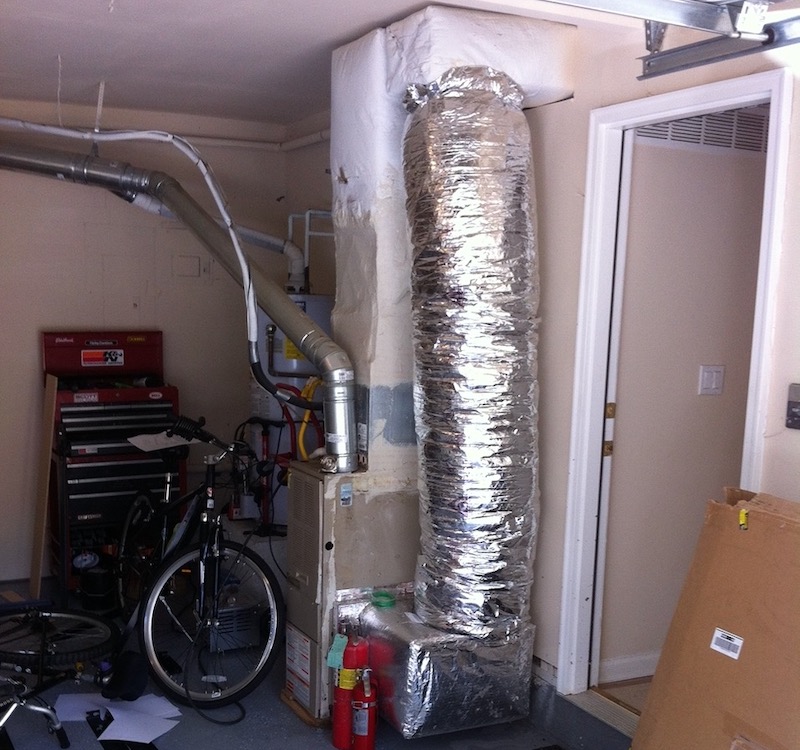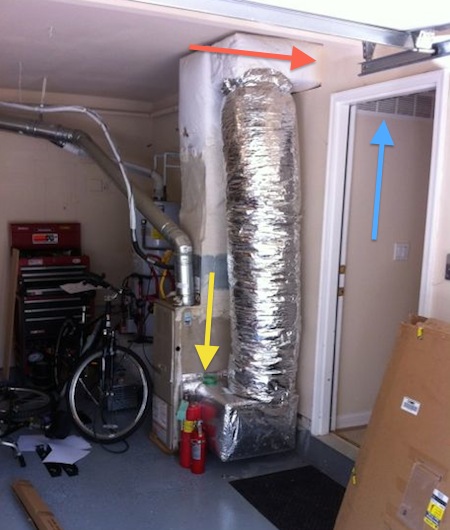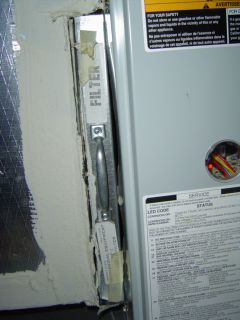Want Bad Air? Put a Heating & Cooling System in Your Attached Garage

I’ve written about how bad it is to put your heating and cooling system in an unconditioned attic, especially in a cooling climate. There’s one place, though, that’s even worse: an attached garage, as shown above. From an efficiency standpoint, the garage would be a better location than an unconditioned attic. The problem here is health and safety. Garage air getting into the home can lead to poor indoor air quality.
Homes with an attached garage generally have higher levels of carbon monoxide. They also have other pollutants in their air. Think of all the stuff that gets stored in garages: lawn mowers, gasoline, paint, pesticides, and more. If you have an attached garage, you want the air in your home to remain free of the stuff out there, right?
It’s possible to keep garage air out of the house, at least to a degree, but you have to do two things:
- Have a good air barrier between the garage and the house.
- Keep the air pressure in the garage lower than the air pressure in the house to prevent infiltration when the door opens.
What’s the problem?
When your heating and cooling system is in the garage, as is the one shown in the photo above, it creates a number of problems. In the photo below, I’ve added three arrows to point to the most egregious of the problems.

Red arrow. This points to a violation of rule #1 above. Where the ducts go through the wall into this house, there’s no air-sealing. Air from the garage can easily get into the house. This one’s not as bad as some that I’ve seen.
Blue arrow. That grille you see there is a return vent. When the heating and cooling system is running, it’s pulling air in. It’s supposed to be pulling air in only from the house but because of air leaks, it also pulls air in from the garage. And of course, every time that door opens when the system is on, it pulls in garage air.
Imagine this is your house. You’ve just come home and parked in the garage. The garage door came down quickly, trapping some of the car’s exhaust fumes, including carbon monoxide. You get out of the car, open  the door into the house, and enter. So does a significant amount of those exhaust fumes. The weatherstripping doesn’t do any good when the door’s open.
the door into the house, and enter. So does a significant amount of those exhaust fumes. The weatherstripping doesn’t do any good when the door’s open.
Yellow arrow. Even if you had a perfect air barrier between your home and the garage, you can still get poison garage air into your home. The yellow arrow is pointing to the filter cover, which had a lot of gaps around it. The one shown at right is from a different house, but it looks similar to the one on the system above.
When the system is running, there’s negative pressure in the return side of the duct system. If there are leaks in the return ducts in the garage, they’ll pull in contaminated garage air—and then distribute it to you and your family through the supply vents in your home.
(This home also has a bonus problem, one that happens to be quite common. The furnace and water heater flues are tied together. See problem #3 in this article I wrote about atmospheric combustion appliances earlier.)
Is this allowed by the building codes?
Sadly, the answer is yes. The building codes say you can put your HVAC system and ductwork in a garage as long as you meet certain requirements. Here are two references:
Mechanical Code 304.6: Appliances located in private garages and carports shall be installed with a minimum clearance of 6 feet above the floor. Exception: The requirements of this section shall not apply where the appliances are protected from motor vehicle impact in accordance with Section 304.3 (which addresses elevation of ignition source).
IRC 309.1.1: Ducts in the garage and ducts penetrating the walls and ceilings separating the dwelling from the garage shall be constructed of a minimum No. 26 gauge steel sheet or other approved material, and shall have no openings in the garage.
There’s another section somewhere, for which I don’t have the reference, that bans the use of solid fuel heating systems in garages. You can put gas furnaces, boilers, and heat pumps out there, but no wood stoves or wood pellet burners.
What should you do?
If you have a heating and cooling system in an attached garage, here are a few things you can do:
- Buy a low-level carbon monoxide monitor, such as the one from CO Experts. Do it now!
- Air seal any penetrations between the attached garage and the house.
- Seal your duct system for leakage. (This is harder than it may seem. If you seal only the return leaks, for example, you may end up causing your home to have negative pressure that pulls more garage air in.)
- Hire a home energy pro to help you come up with the best solution.
If you find yourself with this problem, it’s definitely worth doing something about. Just because you don’t get acutely ill and end up in the hospital doesn’t mean that you don’t have an indoor air quality problem. Remember also that children are more susceptible to pollutants than adults.
Allison A. Bailes III, PhD is a speaker, writer, building science consultant, and the founder of Energy Vanguard in Decatur, Georgia. He has a doctorate in physics and writes the Energy Vanguard Blog. He also has a book on building science coming out in the fall of 2022. You can follow him on Twitter at @EnergyVanguard.
Related Articles
Case Closed: Get Those Air Conditioning Ducts out of the Attic
Comments are closed.
This Post Has 6 Comments
Comments are closed.

Allison, you speak of “.
Allison, you speak of “…Keep the air pressure in the garage lower than the air pressure in the house”. What recommendations do you have for that?
In a cooling climate, one could use a fresh air (FA) intake on the return plenum, to supply additional outside air. Of course duct sealing remains important. Other things being equal, the FA will result in a small positive pressure inside the house, vs. outdoors and presumably vs. the garage. This is fine in a hot-humid climate, but many have said it inadvisable in a heating climate. What other methods could achieve the pressure differential vs. the garage?
One that comes to mind would be a dedicated exhaust fan between the garage and outdoors. With the low wattage type fans (e.g. Panasonic), one could run 24/7 without excessive costs. But does anyone actually do that?
M. Johnson
M. Johnson: You’ve hit the two main ways to do that – positive pressure ventilation system and exhaust fans in garage. As you point out, the former is mainly for use in warmer climates. Some green building programs, like LEED for Homes and EarthCraft House, give points for garage exhaust fans. They require that no HVAC systems be installed in garages but give points for installing exhaust fans in the garage. If you’re installing a fan, they require it to run continuously or be on a timer or motion sensor. I don’t know how many builders do that, but I imagine it’s a small number.
There’s another way to avoid negative pressure in the home, too, and it’s one you’ve mentioned in comments in other articles here. Unbalanced duct leakage with more supply leakage outside than return leakage creates negative pressure in the house.
Sadly I see this all the time
Sadly I see this all the time.
Yet another advantage of electric cars – no CO emissions (from the vehicle) …Be great when EVs w/ solar charging becomes reasonably accessible.
Garage furnaces are very
Garage furnaces are very common where I live. Gas water heaters typically sit next to the furnace, which only adds to the risk.
I heard a story that the local utility killed the local Environments for Living program some years ago when the rater refused to pass homes with garage furnaces. For the most part, builders weren’t cooperative. Those that complied moved furnace to the attic. Sigh.
Furnaces in closets attached
Furnaces in closets attached to the garage is the rule in our area. Typically the water heater is located in the closet also. This is how my own home is set up. Ductwork goes through open ceiling into the attic, then into the house.
I didn’t build the house, but if it was up to me the furnace would go inside along with most if not all of the ductwork.
I was wondering why you were
I was wondering why you were taking pictures of my garage??